A B-cell actomyosin arc network couples integrin co-stimulation to mechanical force-dependent immune synapse formation
- PMID: 35404237
- PMCID: PMC9142150
- DOI: 10.7554/eLife.72805
A B-cell actomyosin arc network couples integrin co-stimulation to mechanical force-dependent immune synapse formation
Abstract
B-cell activation and immune synapse (IS) formation with membrane-bound antigens are actin-dependent processes that scale positively with the strength of antigen-induced signals. Importantly, ligating the B-cell integrin, LFA-1, with ICAM-1 promotes IS formation when antigen is limiting. Whether the actin cytoskeleton plays a specific role in integrin-dependent IS formation is unknown. Here, we show using super-resolution imaging of mouse primary B cells that LFA-1:ICAM-1 interactions promote the formation of an actomyosin network that dominates the B-cell IS. This network is created by the formin mDia1, organized into concentric, contractile arcs by myosin 2A, and flows inward at the same rate as B-cell receptor (BCR):antigen clusters. Consistently, individual BCR microclusters are swept inward by individual actomyosin arcs. Under conditions where integrin is required for synapse formation, inhibiting myosin impairs synapse formation, as evidenced by reduced antigen centralization, diminished BCR signaling, and defective signaling protein distribution at the synapse. Together, these results argue that a contractile actomyosin arc network plays a key role in the mechanism by which LFA-1 co-stimulation promotes B-cell activation and IS formation.
Keywords: B cell; actin; cell biology; immune synapse; immunology; inflammation; integrin; mouse; myosin.
Plain language summary
The immune system has the ability to recognize a vast array of infections and trigger rapid responses. This defense mechanism is mediated in part by B cells which make antibodies that can neutralize or destroy specific disease-causing agents. When pathogens (such as bacteria or viruses) invade the body, a specialized immune cell called an ‘antigen presenting cell’ holds it in place and presents it to the B cell to examine. Receptors on the surface of the B cell then bind to the infectious agent and launch the B cell into action, triggering the antibody response needed to remove the pathogen. This process relies on B cells and antigen presenting cells making a close connection called an immune synapse, which has a bulls-eye pattern with the receptor in the middle surrounded by sticky proteins called adhesion molecules. A network of actin filaments coating the inside of the B cell are responsible for arranging the proteins into this bulls-eye shape. Once fully formed, the synapse initiates the production of antibodies and helps B cells to make stronger versions of these defensive proteins. So far, most studies have focused on the role the receptor plays in B cell activation. However, when there are only small amounts of the pathogen available, these receptors bind to the antigen presenting cell very weakly. When this happens, adhesion molecules have been shown to step in and promote the formation of the mature synapse needed for B cell activation. But it is not fully understood how adhesion molecules do this. To investigate, Wang et al. looked at mouse B cells using super resolution microscopes. This revealed that when B cells receive signals through both their receptors and their adhesion molecules, they rearrange their actin into a circular structure composed of arc shapes. Motors on the actin arcs then contract the structure inwards, pushing the B cell receptors into the classic bullseye pattern. This only happened when adhesion molecules were present and signals through the B cell receptors were weak. These findings suggest that adhesion molecules help form immune synapses and activate B cells by modifying the actin network so it can drive the re-patterning of receptor proteins. B cells are responsible for the long-term immunity provided by vaccines. Thus, it is possible that the findings of Wang et al. could be harnessed to create vaccines that trigger a stronger antibody response.
Conflict of interest statement
JW, YY, XW, VJ, AC, CW, JK, JH No competing interests declared
Figures
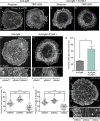


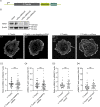

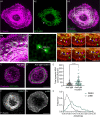


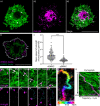

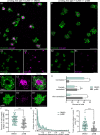
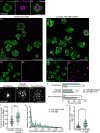
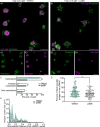
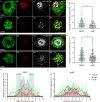



Similar articles
-
Formin-generated actomyosin arcs propel T cell receptor microcluster movement at the immune synapse.J Cell Biol. 2016 Nov 7;215(3):383-399. doi: 10.1083/jcb.201603080. Epub 2016 Oct 31. J Cell Biol. 2016. PMID: 27799367 Free PMC article.
-
F-actin flow drives affinity maturation and spatial organization of LFA-1 at the immunological synapse.J Cell Biol. 2015 Feb 16;208(4):475-91. doi: 10.1083/jcb.201406121. Epub 2015 Feb 9. J Cell Biol. 2015. PMID: 25666810 Free PMC article.
-
Actin retrograde flow and actomyosin II arc contraction drive receptor cluster dynamics at the immunological synapse in Jurkat T cells.Mol Biol Cell. 2012 Mar;23(5):834-52. doi: 10.1091/mbc.E11-08-0731. Epub 2012 Jan 4. Mol Biol Cell. 2012. PMID: 22219382 Free PMC article.
-
The role of actin and myosin in antigen extraction by B lymphocytes.Semin Cell Dev Biol. 2020 Jun;102:90-104. doi: 10.1016/j.semcdb.2019.10.017. Epub 2019 Dec 18. Semin Cell Dev Biol. 2020. PMID: 31862219 Free PMC article. Review.
-
Building the synapse engine to drive B lymphocyte function.Immunol Lett. 2023 Aug;260:68-72. doi: 10.1016/j.imlet.2023.06.010. Epub 2023 Jun 25. Immunol Lett. 2023. PMID: 37369313 Review.
Cited by
-
Mechanical control of antigen detection and discrimination by T and B cell receptors.Biophys J. 2024 Aug 6;123(15):2234-2255. doi: 10.1016/j.bpj.2024.05.020. Epub 2024 May 23. Biophys J. 2024. PMID: 38794795 Free PMC article. Review.
-
WAVE2 Regulates Actin-Dependent Processes Induced by the B Cell Antigen Receptor and Integrins.Cells. 2023 Nov 25;12(23):2704. doi: 10.3390/cells12232704. Cells. 2023. PMID: 38067132 Free PMC article.
-
DNA Nanotechnology for Investigating Mechanical Signaling in the Immune System.Angew Chem Int Ed Engl. 2023 Jul 24;62(30):e202302967. doi: 10.1002/anie.202302967. Epub 2023 May 15. Angew Chem Int Ed Engl. 2023. PMID: 37186502 Free PMC article. Review.
-
N-WASP-dependent branched actin polymerization attenuates B-cell receptor signaling by increasing the molecular density of receptor clusters.Elife. 2023 Dec 12;12:RP87833. doi: 10.7554/eLife.87833. Elife. 2023. PMID: 38085658 Free PMC article.
-
Traditional Chinese medicines and natural products targeting immune cells in the treatment of metabolic-related fatty liver disease.Front Pharmacol. 2023 Jun 9;14:1195146. doi: 10.3389/fphar.2023.1195146. eCollection 2023. Front Pharmacol. 2023. PMID: 37361209 Free PMC article. Review.
References
Publication types
MeSH terms
Substances
Associated data
Grants and funding
LinkOut - more resources
Full Text Sources
Other Literature Sources
Molecular Biology Databases
Miscellaneous

